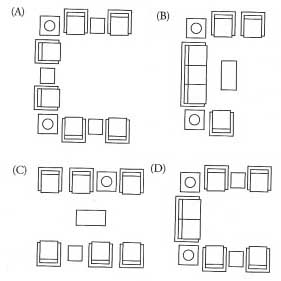In what way should an interior designer NOT transmit a purchase order...
Which fiber is generally the least expensive?
A composition of furniture and architectural elements organized around...
When the interior designer does not want furniture to be delivered to...
Which of the following drawings would be most needed to begin space...
The most naturally fire-resistant untreated fabric is
A client has requested that she be able to look at a sofa the interior...
Information regarding standard test methods for evaluating a prduct...
Which seating group shown would be best for planning a waiting area to...
What is the maximum distance that a door can encroach into an exit...
What should be called out on a cabinet drawing to ensure a good fit...
When specifying the method by which two veneer peices are to be...
When selecting paint for a hospital, which of the following criteria...
Which part of a cabinet is typically built with 1/4 in panel product?
About how much space should be left between a desk and a credenza...
In determining required space for a hospital nurses' station, which is...
For the most durable wood finish, which of the following finish types...
A Class A fabric will not
What is the best source from which to get information about a...
Commercial-grade cabinets are most often constructed of panel products...
What is contained in a mart?
Under the AIA A275?ID, General Conditions fo the Contract for...
When space planning a high-use commercial office building, what would...
Planning an inteior in a building with an atrium would suggest which...
Planning an interior in a long rectangular building would suggest...
Which architect developed the Modular System?
What most affects the flammability of upholstery?
Which sequence of numbers is the correct representation of the...
Which of the following existing conditions will have the LEAST impact...
What type of cushioning would be best for a hospital waiting room?
If you were specifying the fabric for sofas in a sunroom, which would...
In what order of importance should tables ofr a college library be...
NFPA 701 relates to which of the following items?
The joint shown is a
LEED credit is only available when
What does the standard ANSI/BIFMA X5.3 provide manufacturers,...
Which fiber is rarely used for upholstery?
Which method of veneer cut results in the straightest grain possible...
An interior designer could determine what products an independent...
Which document provides the designer with verification that an item...
The most efficient type of circulation system for the majority of...
Which durability test is NOT concerned with abrasion resistance?
What testing standard should be specified for the durability of office...
What fabric would have the best appearance for the longest time when...
The best way to avoid fabric slippage over a cushion would be to...
How can a drapery treatment be changed to minimize its hazards during...
A designer uses the principle of harmony in order to
In creating drawings for paneling that will be suspended from a wall...
If 13 black and white photographs, all framed with different styles...
The joint shown is a
Which of the following represents the golden proportion?
The joint shown is a
An interior designer has written furniture specifications for a...
The most effective design strategy an interior designer can use to...
Of the open plan workstations shown, which is most efficient and most...
If minimizing cost is a concern, which style of cabinet door and...
The perception of symmetry is most likely to occur along which axis?
Detailed information about furniture is typically found on
The LEAST important consideration in planning exit corridors is
What is the primary consideration when specifying paneling?
Which method of assembling panels within a room results in the LEAST...
The client is most typically involved with procurement of furniture...
If an open office is being planned in a building that has 8 ft high...
Which type of seaming would be LEAST appropriate for seating where...
What performance tests should be specified for a custom-blended fabric...
The flame-spread rating of wood panel wainscoting must be
The ________ is expressed as a percentage, and is the ratio of...
What should the packing list be checked against when a shipment...
Which of te following statements is LEAST accurate in describing...
What interior design service is normally performed during the contract...
When a fabric has been fire-retardant treated, it will
The Mall of America is an example of which type of circulation...
For a restaurant in an old building undergoing remodeling, what would...
Which synthetic fiber is often used as a replacement for wool?
A casual restaurant uses dining tables with identical bases but with...
What is the most fire-resistant type of cushioning?
















